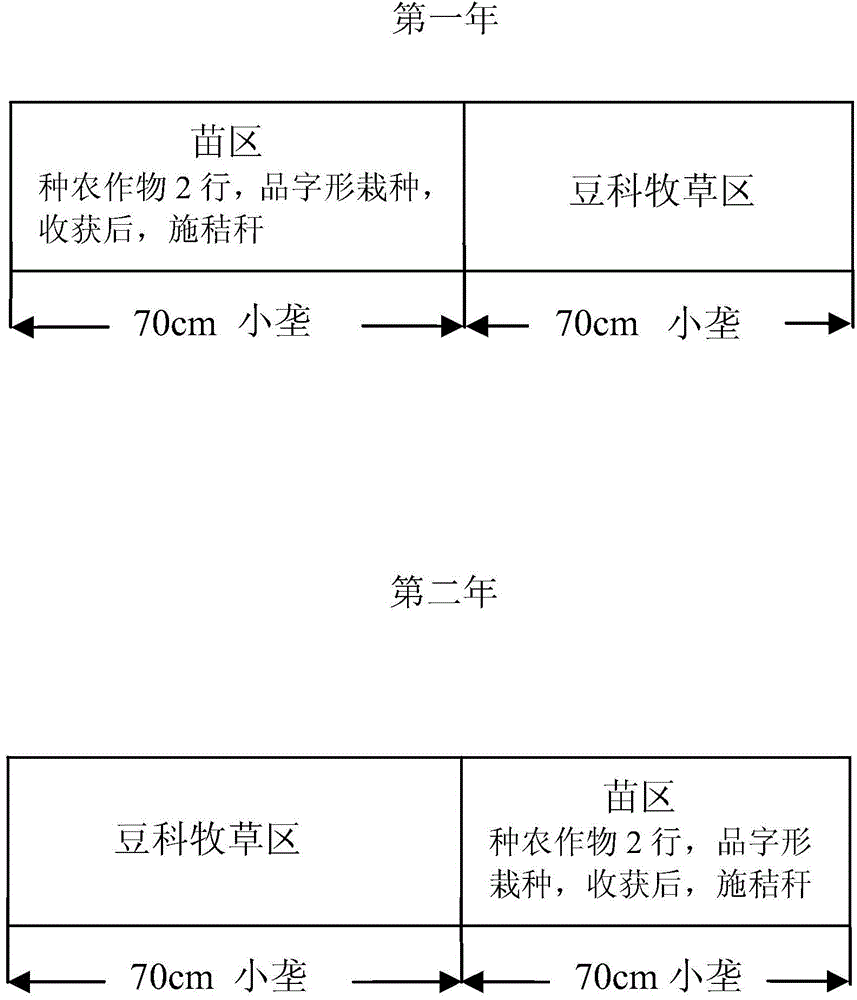Protective farming and cultivating method
A cultivation method and protective technology, which can be applied in the fields of dichotomous grain and grass intercropping, deep loosening and straw returning, and crop farming and cultivation, can solve the problem of reducing soil moisture and soil moisture resistance to evaporation, easily killing beneficial soil organisms, and reducing soil water storage. capacity and other issues, to achieve the effect of improving comprehensive production capacity, avoiding nitrogen volatilization loss, and promoting sustainable development.
- Summary
- Abstract
- Description
- Claims
- Application Information
AI Technical Summary
Problems solved by technology
Method used
Image
Examples
Embodiment 1
[0022] On the basis of plowing the ground in autumn, divide the seedling area and the leguminous pasture area on a small ridge with a regular row spacing of 70 cm, and use a double-row precision seeder to precisely sow corn seeds on-demand in the seedling area. A suitable layer of soil is enough, the depth is about 5-10cm, and it can be planted properly, with a distance of 25cm, planted in 2 rows, and planted in a zigzag shape. The stubble remains on the ground, and the height of the stubble is basically 20cm. In mid-June, a subsoiling and topdressing machine is used to implement subsoiling and deep topdressing in the seedling area. After the autumn crops are harvested, the planting belt of the seedling area uses a chopping and returning machine to chop the straw and apply it to the seedling area, and the leguminous pasture area uses a small rotary tiller to level the soil to prepare the seed bed for the next year.
[0023] In the second year, in the first year of rotary tilla...
Embodiment 2
[0026] On the basis of plowing the ground in autumn, divide the small ridges with a uniform row spacing of 70 cm into the seedling area and the pasture area, and use a seeder to sow corn seeds in the seedling area. The width and depth of the ditch only need to cover the seeds with an appropriate layer of soil The depth is about 5-10cm, the spacing is 25cm, and one row is planted. The stubble remains on the ground, and the height of the stubble is basically 15cm. In mid-June, a subsoiling and topdressing machine is used to implement subsoiling and deep topdressing in the seedling area. After the autumn crops are harvested, the planting belt of the seedling area uses a chopping and returning machine to chop the straw and apply it to the seedling area. In the pasture area, a small rotary tiller is used to level the soil and prepare a seed bed for the next year.
[0027] In the second year, the pasture area in the first year of rotary tillage leveling was sown with a seeder. The s...
PUM
 Login to View More
Login to View More Abstract
Description
Claims
Application Information
 Login to View More
Login to View More - R&D
- Intellectual Property
- Life Sciences
- Materials
- Tech Scout
- Unparalleled Data Quality
- Higher Quality Content
- 60% Fewer Hallucinations
Browse by: Latest US Patents, China's latest patents, Technical Efficacy Thesaurus, Application Domain, Technology Topic, Popular Technical Reports.
© 2025 PatSnap. All rights reserved.Legal|Privacy policy|Modern Slavery Act Transparency Statement|Sitemap|About US| Contact US: help@patsnap.com

